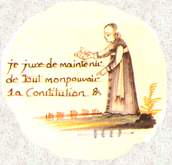
Oath of the priests swearers
November 27, 1791
" I swear to maintain of all my capacity the Constitution ". The priests who lent this oath were called swearers, the others will be the refractories.
It is the decree of 27 November 1790 giving obligation to the ecclesiastics to lend oath of fidelity to the Nation, the law, to the king and thus to the civil Constitution of the clergy which will precipitate the fracture between the Church and the Nation.
 |
Oath of the priests swearers November 27, 1791 " I swear to maintain of all my capacity the Constitution ". The priests who lent this oath were called swearers, the others will be the refractories. |
The multiplication of the bishops protesting against the civil constitution, the position of the pope and the hesitations of the king had decided the assembly to ask for the service of this oath. The voted decree, it missed the sanction of the king whom it gave to against heart on December 26, 1790.
The clergy had eight days to lend oath. January 4, 1791 only 105 ecclesiastical deputies had lent the oath. Almost the whole of the bishops and two thirds of the appointed priests - yesterday sincerely devoted to the revolution and laid out to accept the civil constitution - refuse to lend the oath. Much of them was sensitive to the pressure exerted on them since the platforms and swore but, thereafter, with the retractions there were on the whole only 99 swearers with the Assembly.
The day of the national oath of all the other ecclesiastics, envisaged Sunday January 9, 1791, was thus announced badly. The bishops refused to lend oath (except 4 of them Talleyrand, Loménie de Brienne, Jarente and Lafont de Savine). A small half only of the priests swore but to retract partly when Pie VI had made appear the judgment pronounced against the civil constitution.
The clergy was cut into two. The proportion of the priests swearers vary according to areas' of 8% in the Low Rhine with 96% in the VAr but the non-jurors were ultimately most numerous.
The refusal to swear thus required a replacement of the " refractory " ecclesiastics, 80 episcopal sees and 20000 cures were thus subjected to election. The bishops were elected between February and May 1791; among them 19 priests of the assembly of which Gregoire. The participation in these elections was very weak and primarily layman. Talleyrand crowned the first three bishops of the new church on February 20, 1791. The elections of the priests were animated, the parishes refused the departure of their refractory priests, the candidates were very few and, moreover, a number of them refused their post office after the election. The judgment of the pope Pie VI arrived with his briefs of March and April 1791 in which it declared the constitution civil like schismatic. Louis XVI, sincere catholic, were shocked by it because it felt responsible to have given its sanction to this law.
Thereafter, the war that the two respective clergies and their partisans delivered themselves was much more serious. The clergy non-juror refused to leave the place to the clergy swearer. If there were little conflict on the level of the bishops, much of leaving having emigrated, on the level of the parishes there were confrontations between the two parties. Public peace was threatened. The revolution also was threatened because it ran up against one of the popular feelings most anchored to the level of the people: the catholic feeling.
| For this period under the pressure of Hébertistes (1) of the collective scenes of abjuration of the faith, of plunderings of tombs and the processions ridiculing |  |
the religion catholics were organized.
Festivals of the goddess " reason " took place in the churches where the statues of the Virgin Mary were replaced by statues of Freedom.
The bell-towers were cut down under pretext that their domination on the other buildings seemed to oppose the principle of the Equality.